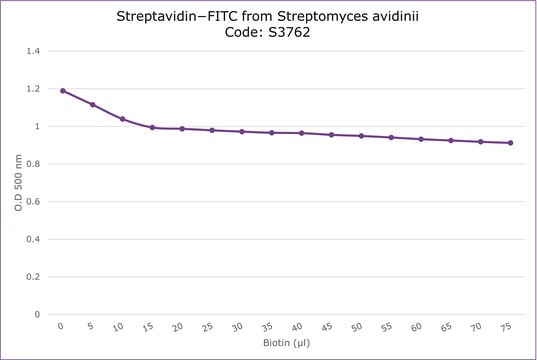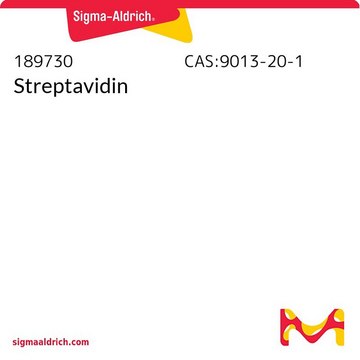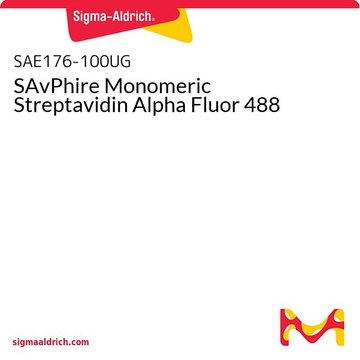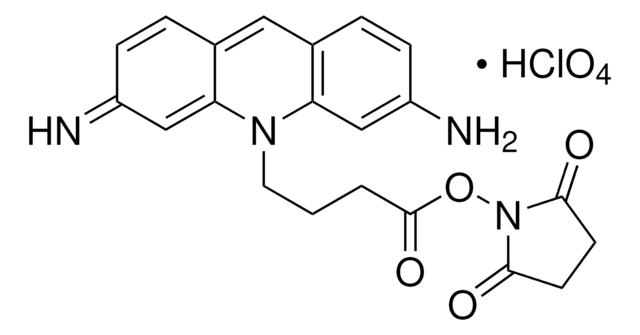40709
Atto 590-Streptavidin
BioReagent, suitable for fluorescence
Synonym(s):
Streptavidin-Atto 590
Sign Into View Organizational & Contract Pricing
All Photos(1)
About This Item
Recommended Products
product line
BioReagent
Quality Level
form
powder
manufacturer/tradename
ATTO-TEC GmbH
fluorescence
λex 590 nm; λem 619 nm in 0.1 M phosphate pH 7.0
suitability
suitable for fluorescence
storage temp.
−20°C
Application
Atto 590 is a new label with high molecular absorption (120.000) and quantum yield (0.80) as well as sufficient stoke′s shift (excitation maximum 594 nm, emission maximum 624 nm). Atto 590 has been coupled to streptavidin to enable all kinds of assays based on the specific affinity of biotin to streptavidin. Streptavidin conjugates are used as secondary detection reagents in histochemical applications, flow cytometry, microarrays, blot analysis and immunoassays. Streptavidin conjugation of Atto 590 does not significantly change the labels spectral data regarding excitation and emission maxima. Given the optimized Dye/Protein-ratio molar absorbance and quantum yields remain high within application. Conjugates of our Atto dyes generally do not show strong fluorescence in unbound state, but fluorescence is boosted again as soon as they are bound to biotin. This may help overcome problems by unspecific binding which may sometimes appear with streptavidin based assays in special cases.
Analysis Note
free of unconjugated dye
Legal Information
This product is for Research use only. In case of intended commercialization, please contact the IP-holder (ATTO-TEC GmbH, Germany) for licensing.
Storage Class Code
11 - Combustible Solids
WGK
WGK 3
Flash Point(F)
Not applicable
Flash Point(C)
Not applicable
Personal Protective Equipment
dust mask type N95 (US), Eyeshields, Gloves
Certificates of Analysis (COA)
Search for Certificates of Analysis (COA) by entering the products Lot/Batch Number. Lot and Batch Numbers can be found on a product’s label following the words ‘Lot’ or ‘Batch’.
Already Own This Product?
Find documentation for the products that you have recently purchased in the Document Library.
Customers Also Viewed
Ronit Freeman et al.
Nano letters, 10(6), 2192-2196 (2010-05-21)
Semiconductor quantum dots (QDs) are used for the optical analysis of casein kinase (CK2) or the hydrolytic activity of alkaline phosphatase (ALP). Two schemes for the analysis of CK2 by a FRET-based mechanism are described. One approach involves the CK2-catalyzed
Andrea D Lehmann et al.
Small (Weinheim an der Bergstrasse, Germany), 6(6), 753-762 (2010-03-06)
Iron-platinum nanoparticles embedded in a poly(methacrylic acid) (PMA) polymer shell and fluorescently labeled with the dye ATTO 590 (FePt-PMA-ATTO-2%) are investigated in terms of their intracellular localization in lung cells and potential to induce a proinflammatory response dependent on concentration
Mariela M Marani et al.
Journal of combinatorial chemistry, 11(1), 146-150 (2008-12-17)
To screen one-bead-one-compound (OBOC) combinatorial libraries, tens of thousands to millions of compound beads are first mixed with a target molecule. The beads that interact with this molecule are then identified and isolated for compound structure determination. Here we describe
Ningtao Li et al.
Frontiers in endocrinology, 11, 545973-545973 (2020-10-27)
Testosterone (T), predominantly acting through its derivative 17β-estradiol (E2), regulates the brain's sexual differentiation in rodents during the perinatal sensitive period, which mirrors the window of vulnerability to the adverse effects of general anesthetics. The mechanisms of anesthesia's adverse effects
Stimulated emission depletion-based raster image correlation spectroscopy reveals biomolecular dynamics in live cells.
Hedde P.N.; et al.
Nature Communications, 4, 2093-2093 (2013)
Articles
Fluorescent Labeling of Peptides
Our team of scientists has experience in all areas of research including Life Science, Material Science, Chemical Synthesis, Chromatography, Analytical and many others.
Contact Technical Service





